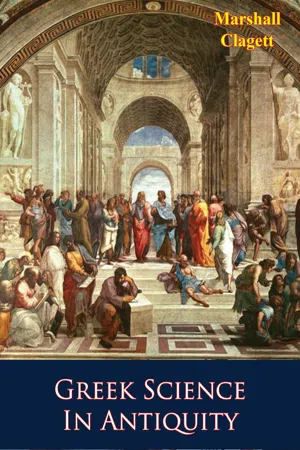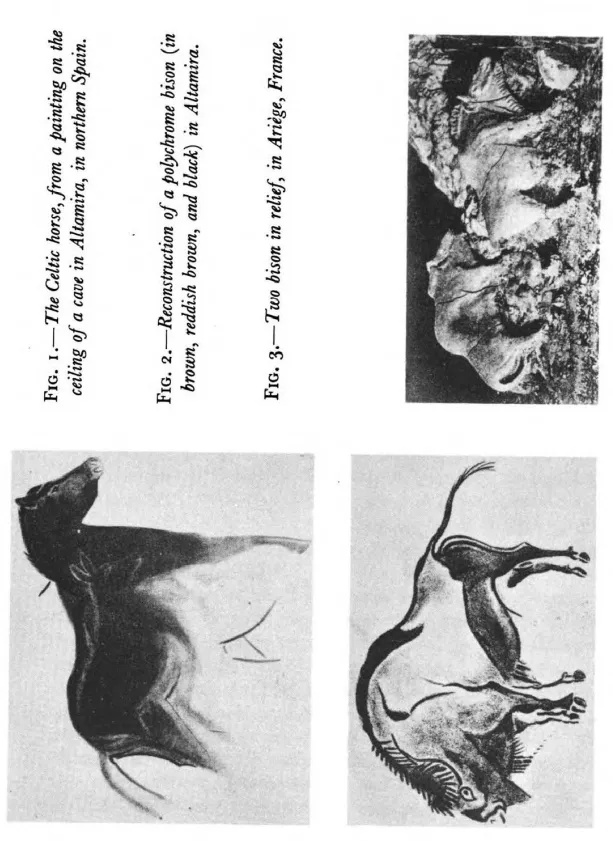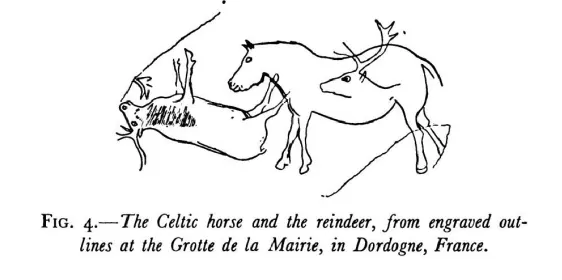
eBook - ePub
Greek Science In Antiquity
Marshall Clagett
This is a test
- 215 pages
- English
- ePUB (adapté aux mobiles)
- Disponible sur iOS et Android
eBook - ePub
Greek Science In Antiquity
Marshall Clagett
Détails du livre
Aperçu du livre
Table des matières
Citations
À propos de ce livre
In this volume I have attempted to give especial and marked attention to the fate of Greek science in late antiquity. Elementary texts in the past have long ignored this aspect of Greek science. The importance of the course of Greek science in late antiquity is evident, for it was during this period that much of the Greek scientific corpus was put into the form in which it passed to the medieval Latin West. We are justified, then, in considering this volume as an introduction to medieval and early modern science—that science being considered as a transformation of Greek science.
Foire aux questions
Comment puis-je résilier mon abonnement ?
Il vous suffit de vous rendre dans la section compte dans paramètres et de cliquer sur « Résilier l’abonnement ». C’est aussi simple que cela ! Une fois que vous aurez résilié votre abonnement, il restera actif pour le reste de la période pour laquelle vous avez payé. Découvrez-en plus ici.
Puis-je / comment puis-je télécharger des livres ?
Pour le moment, tous nos livres en format ePub adaptés aux mobiles peuvent être téléchargés via l’application. La plupart de nos PDF sont également disponibles en téléchargement et les autres seront téléchargeables très prochainement. Découvrez-en plus ici.
Quelle est la différence entre les formules tarifaires ?
Les deux abonnements vous donnent un accès complet à la bibliothèque et à toutes les fonctionnalités de Perlego. Les seules différences sont les tarifs ainsi que la période d’abonnement : avec l’abonnement annuel, vous économiserez environ 30 % par rapport à 12 mois d’abonnement mensuel.
Qu’est-ce que Perlego ?
Nous sommes un service d’abonnement à des ouvrages universitaires en ligne, où vous pouvez accéder à toute une bibliothèque pour un prix inférieur à celui d’un seul livre par mois. Avec plus d’un million de livres sur plus de 1 000 sujets, nous avons ce qu’il vous faut ! Découvrez-en plus ici.
Prenez-vous en charge la synthèse vocale ?
Recherchez le symbole Écouter sur votre prochain livre pour voir si vous pouvez l’écouter. L’outil Écouter lit le texte à haute voix pour vous, en surlignant le passage qui est en cours de lecture. Vous pouvez le mettre sur pause, l’accélérer ou le ralentir. Découvrez-en plus ici.
Est-ce que Greek Science In Antiquity est un PDF/ePUB en ligne ?
Oui, vous pouvez accéder à Greek Science In Antiquity par Marshall Clagett en format PDF et/ou ePUB ainsi qu’à d’autres livres populaires dans History et Egyptian Ancient History. Nous disposons de plus d’un million d’ouvrages à découvrir dans notre catalogue.
Informations
Sujet
HistorySous-sujet
Egyptian Ancient HistoryPART I—THE ORIGINS OF SCIENCE IN ANTIQUITY
CHAPTER ONE—Science in Egypt and Mesopotamia
I
TODAY most of us are keenly aware of the close ties that exist between science and the character of our civilization. The historian of science hopes to throw light on this relationship by investigating how and why science grew out of the more general province of learning to occupy its dominant position. In this investigation he must study the unfolding life of science. He must, in addition, evaluate the details uncovered and judge their significance for modern scientific attitudes, principles, and methods.
As in the history of any other aspect of man’s activity—politics, economics, religion, etc.—so in the history of his science, a study of the early stages of growth is of great importance for an understanding of the modern institution. This volume attempts to treat the phases of science that lie in antiquity—from the very early empirical efforts of prehistoric man through the relatively mature scientific activities in Greek antiquity. Our volume will, then, cover an enormous period of time, of which the beginning is unrecorded and the terminal date is about A.D. 600.
It is generally agreed that the learning of antiquity was digested in the Middle Ages and Renaissance to form the chief nourishment for growth of early modern thought. Thus early modern science grew out of Greek science and philosophy as modified by the natural philosophers of Islam and the Latin West. The acceptance of this essential continuity in the development of Western thought does not obviate the novelty of the scientific activity of the seventeenth century, the century of Galileo, Boyle, Hooke, Leibniz, and Newton. It serves rather to clarify that novelty, to show how it arose in great part from the interplay, modification, and rearrangement of older stock ideas as they were fashioned into an essentially new system.
In the course of our inquiry into the foundations of science we must direct our attention toward many aspects and features of intellectual activity so that we may achieve a relatively complete picture. Special care must be exercised in the exposition and evaluation of the more important scientific principles, laws, and theories that matured, suffered modification, or originated in antiquity. But the mere cataloguing of the substantial scientific knowledge of antiquity would ill satisfy our objective. We must also turn our attention to the methods and procedures pursuant to that science. We must show the relative importance of revelation, authority, reason, experience, and experimentation, and how the emphasis on one or another of these factors changed. And we must examine the more general philosophical ideas that influenced both the method and the substance of science in antiquity, particularly during the beginnings of Greek science.
In setting out to characterize this young, active, and exciting period in the life of science, we should, no doubt, state our definition of science, although we are tempted, like one recent historian of science, to beg the question until the history has been written and the reader can judge for himself what kind of enterprise has been described-The difficulty is that there is little agreement on the question of definition among the professional scientists or among historians and philosophers of science. And yet most of us have a rather intuitive understanding of the province of science and to some extent of its methods. Schoolboys speak easily of laboratories with betatrons, of fission, of penicillin, of frequency modulation, of the expanding universe, and of a myriad of other scientific topics. It will nevertheless be useful to go beyond our ill-defined intuition of science to accept some definition, however arbitrary, as a point of departure for this study.
For the sake of breadth we would be inclined to accept the definition of one of our greatest living historians of science, George Sarton, who defines science as systematized positive knowledge, were it not for the fact that the term “positive” is ambiguous and demands commentary. Also, this definition would seem to deny or at least to exclude important non positivistic elements that were once closely united with science—e.g., magic. We can, perhaps, avoid these difficulties and still retain sufficient breadth by assuming that science comprises, first, the orderly and systematic comprehension, description, and/or explanation of natural phenomena and, secondly, the tools necessary for that undertaking. The first part of the definition permits us to inquire into man’s scientific activity even in times of which we have no written records. The latter part of the definition allows us to treat the growth of mathematics and logic as a part of the history of science.

II
Science as an orderly and rational structure scarcely goes beyond the Greeks into the early history of man. Yet we should be aware of the countless centuries of man’s activity before the inception of written records, as well as of the two thousand years or so of “civilized” activity before the emergence of Greek culture.
In prehistory—before the invention of writing—Stone Age man left us many evidences of his understanding of nature. Who cannot feel the eye for naturalistic detail revealed in the Stone Age wall paintings and reliefs in the caves of southern France and northern Spain (see Figs. 1-4)? Man was a naturalist long before he was a farmer, an architect, or a politician. At the same time, there can be little doubt that in the manufacture of his tools early man made a permanent record of his experience with and understanding of nature. This idea has been developed in an interesting, if somewhat extravagant, way by the British archeologist V. Gordon Childe in various of his publications. Childe sees the tool as “an embodiment of science...a practical application of remembered, compared, and collected experience of the same kind as are summarized in scientific formulae, descriptions, and prescriptions.” Although this statement glosses too readily over the generalization and abstraction involved in scientific formulae and description, there is a kernel of truth in its representation of the tool as a product of man’s understanding of nature.

In studying the activity of early man, Childe and other historical materialists have done important service by emphasizing the influence of man’s technological activities upon both his general cultural development and his particular scientific advances. The control and use of fire was one of his earliest cultural discoveries and certainly one of the most significant. The chemical and metallurgical arts stem from that fundamental discovery and the complementary discovery that charred wood ignites more easily than un charred. Thus early man had the chief instrument for learning the proto chemistry involved in the firing and burnishing of pots and in the working of metals.
Man emerged into civilization in the fourth millennium B.C. in at least three important areas: the Nile Valley, Mesopotamia, and the Indus Valley. This emergence was due in part to his discovery of the use and working of metals. With the coming of the metal ages his practical knowledge of natural phenomena multiplied. He learned to reduce and work copper, to make use of its ready malleability and fusibility, to alloy it with tin to produce bronze, to make castings by delicate and sure processes. He also made brick arches, caught the wind in sail, and applied the wheel to pot and vehicle. He learned to do all this, no doubt, by a long and arduous trial-and-error method—or, we may say, by experimentation, so long as we are careful to distinguish the experimentation involved in the discovery and improvement of the technological arts from the planned experimentation used for the confirmation of scientific theory. Finally, with the invention of writing, possibly first in the area of Mesopotamia about the middle of the fourth millennium B.C., man stepped over the threshold of civilization. This invention has been described by some authors as a social accident tied in with the development of ownership signs and property lists. It has, of course, been the chief instrument in the perfection of man’s cultural and thus of his scientific achievement.
III
The study of rationally organized scientific activity, as distinguished from handicraft activity, in two of the first areas of civilization, Egypt and Mesopotamia, reveals advances primarily in mathematics and astronomy, and in some aspects of medical practice. The rest of man’s understanding and description of nature remained either entirely in the state of technology, as in the case of his knowledge of chemical and mechanical principles, or in that of mythology and magic, as in the case of his cosmology and much of his medicine.
Just as the approach of the early inhabitants of Egypt and Mesopotamia toward the origin of the world and man was almost entirely mythological and religious, and just as their reliance for the explanation of natural phenomena was upon supernatural causation, so much of the medical practice in Egypt and Babylonia was based upon belief in other than natural causes. There was considerable dependence upon incantations and other magical cures. For example, one of the medical papyri from Egypt, the so-called Ebers Papyrus, compiled in the eighteenth dynasty (about 1500 B.C.), presents considerable evidence that the sorcerer worked side by side with the ordinary practitioner (and, no doubt, was often the same person), utilizing spells and incantations for desired therapeutic ends. Thus, in applying malachite for a cataract of the eye, we are told to incant the following, after having pounded malachite with honey: “Come Malachite. come thou green one; Come discharge from Horus’ eye. Come secretion from Atum’s eye. Come fluid that has come out of Osiris....” G. Conteneau, the most able historian of medicine in the Mesopotamian area, shows how thoroughly bound to the whim of gods was the Assyrian-Babylonian pathology and therapeutics. Medical treatment in numerous cases took the form of mollifying the gods by prayer and sacrifice and expelling demons by incantations and medicines.
But there is one medical treatise from early antiquity that makes us hesitate in dismissing Egyptian medicine, at least, as completely magic-perverted. This is the renowned Edwin Smith Surgical Papyrus. Named for its modern purchaser, it was copied in the seventeenth century B.C. from a work of the third millennium B.C. Free of the magical features of other Egyptian medical works, it is organized in a systematic manner and approaches a scientific presentation of empirical data. Although incomplete, it contains forty-eight cases involving injuries and wounds to various parts of the body. It starts with cases occurring to the head—to the nose, face, and ears—and then proceeds to the collarbone, humerus, thorax, shoulder, and spinal column. The presentation of each case is divided into a title, an examination, a diagnosis and opinion, a treatment, and glosses to explain already antique and specialized terminology.
Almost as remarkable as the quasi-scientific organization of the treatise is its clear indication of the straightforward simplicity and restraint practiced in the cures. Particularly noteworthy is the admission in some thirteen cases that the wound is fatal—i.e., it is an “ailment not to be treated.” J. H. Breasted, the modern editor and translator of the papyrus, in his edition (which will remain one of the great monuments of careful and complete scholarship in the fields of Egyptology and the history of medicine) justly remarks on the significance of describing cases not treatable.
“The inclusion of these thirteen hopeless cases (about one fourth of the material in the treatise as preserved to us) is a remarkable evidence of the surgeon’s scientific interest in recording and discussing the observable facts in a group of cases for which he could suggest no treatment. (J. H. Breasted, The Edwin Smith Surgical Papyrus, Vol. 1, Chicago, 1930, P-47)”{1}
It has been suggested that the inclusion of hopeless cases demonstrates less scientific prudence than a reluctance to face the social, or perhaps even legal, reprisals against unsuccessful diagnosis and treatment.
The factual anatomical knowledge exhibited by Egyptian medical writings is not extensive. But the Edwin Smith papyrus does give us the first, although incomplete, description of the brain, and it says something of the brain as a control center for the nervous system, It also takes note of the use of the pulse “to know the action of the heart,” and it reveals a rudimentary knowledge of the blood system, although there is no evidence of an understanding of the circulation of the blood. Citation here of Case 6 will give the reader a vivid picture of both the organization of and the state of the substantial surgical knowledge in the treatise.
CASE 6
(Title) Instructions concerning a gaping wound in his head, penetrating to the bone, smashing his skull, (and) rending open the brain of his skull.
(Examination) If thou examinest a man having a gaping wound in his head, penetrating to the bone, smashing his skull, and rending open the brain of his skull, thou shouldst palpate [i.e., feel with your fingers] his wound. Shouldst thou find that smash which is in his skull [like] those corrugations which form in molten copper, (and) something therein throbbing (and) fluttering under thy fingers, like the weak place of an infant’s crown before it becomes whole...(and) he [the patient] d...
Table des matières
- Title page
- TABLE OF CONTENTS
- DEDICATION
- PREFACE
- ILLUSTRATIONS
- PART I-THE ORIGINS OF SCIENCE IN ANTIQUITY
- PART II-SCIENCE IN LATE ANTIQUITY
- APPENDIX I-ARCHIMEDES AND THE QUADRATURE OF THE CIRCLE
- APPENDIX II-ARCHIMEDES AND THE APPLICATION OF MECHANICS TO GEOMETRY
- APPENDIX III-APOLLONIUS OF PERGA AND THE DEVELOPMENT OF CONIC SECTIONS
- APPENDIX IV-ARCHIMEDES’ PROOF OF THE LAW OF THE LEVER
- APPENDIX V-EQUIVALENCE OF EPICYCLE AND ECCENTRIC MOVEMENTS FOR THE SUN
- APPENDIX VI-THE MOVEMENTS OF THE PLANETS AND THE MOON ACCORDING TO PTOLEMY
- APPENDIX VII-PTOLEMY’S TABLE OF CHORD LENGTHS
- FURTHER READINGS
- BIBLIOGRAPHY
Normes de citation pour Greek Science In Antiquity
APA 6 Citation
Clagett, M. (2016). Greek Science In Antiquity ([edition unavailable]). Hauraki Publishing. Retrieved from https://www.perlego.com/book/3019107/greek-science-in-antiquity-pdf (Original work published 2016)
Chicago Citation
Clagett, Marshall. (2016) 2016. Greek Science In Antiquity. [Edition unavailable]. Hauraki Publishing. https://www.perlego.com/book/3019107/greek-science-in-antiquity-pdf.
Harvard Citation
Clagett, M. (2016) Greek Science In Antiquity. [edition unavailable]. Hauraki Publishing. Available at: https://www.perlego.com/book/3019107/greek-science-in-antiquity-pdf (Accessed: 15 October 2022).
MLA 7 Citation
Clagett, Marshall. Greek Science In Antiquity. [edition unavailable]. Hauraki Publishing, 2016. Web. 15 Oct. 2022.